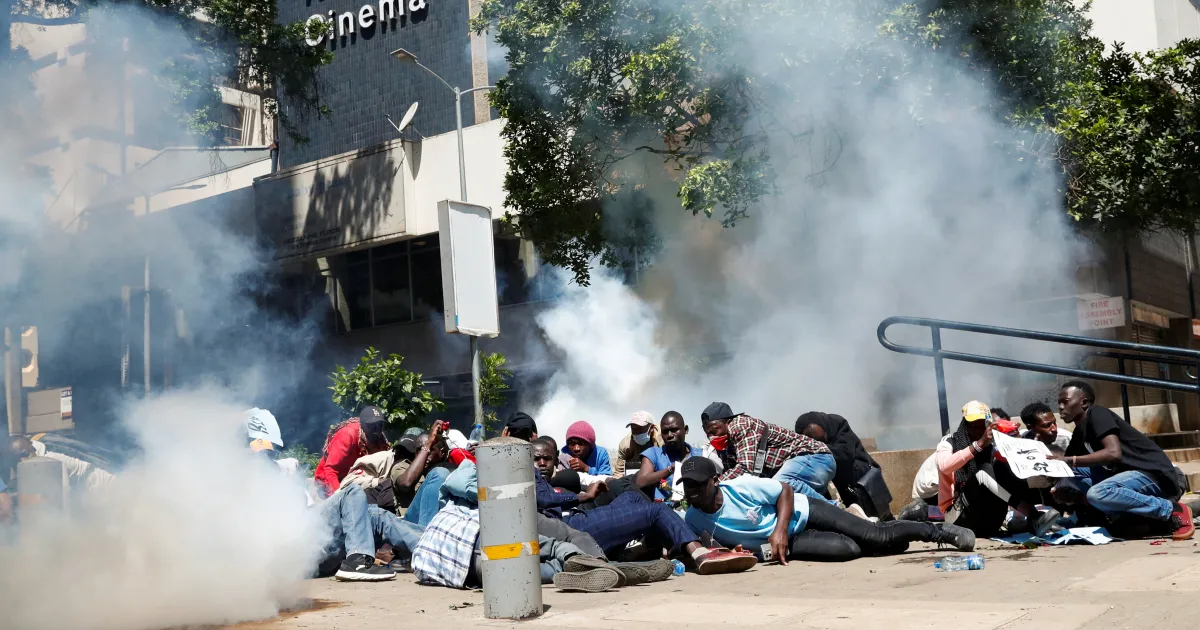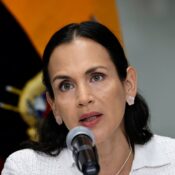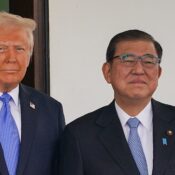
How Kenyan police concealed the deaths of demonstrators against the government
Charles Owino, 19, was shot in the head during a day of anti-government demonstrations in the vicinity of Nairobi in July, according to an autopsy report seen by Reuters.
However, his brother said that when he saw Owino’s body, Kenyan police had documented his death as a traffic accident, citing the morgue logbook. There is no copy of the logbook entry that Reuters has seen.
In a another case, authorities said that Shaquille Obienge, 21, passed away in a traffic accident. His father confirmed this to Reuters, citing a note in the morgue logbook.
However, the government’s own autopsy report, which was completed after his father visually recognized his body, states that Obienge was shot in the neck.
In the same Nairobi suburb of Kitengela, Obienge, a protester as well, passed away on the same day as Owino, according to the information seen by Reuters.
In Kenya, police register the cause of death in morgue logbooks when they bring in bodies, and public pathologists often don’t do autopsy until after family members have identified the deceased.
In order to hide their tracks, Kenyan police may misreport officer-caused deaths in morgue logs as “death by accident,” “mob justice,” or “drownings,” according to three police officers who serve in a unit stationed during rallies and interviewed by Reuters. To discuss delicate subjects, the police want to remain anonymous.
Copies of four postmortem reports completed by public pathologists were seen by Reuters for this article after family members recognized Owino, Obienge, and two other young men who were slain during or during the anti-government demonstrations that shook the nation in June and July.
In three of the cases, relatives reported differences between the authorities’ documented causes of death in the morgue logbooks and the autopsy results.
The morgue staff assigned a number to each body and recorded it in the logbook. Even though Obienge and Owino’s names were not recorded when they were brought to the morgue, their family members were able to view the police-reported cause of death and compare the body’s number with the logbook entry.
Reuters was unable to independently confirm the families’ claims.
Police blamed “mob justice” for Kepher Odiwuor Ouma’s third death, according to his relatives, who cited the morgue logbook that listed him. However, two witnesses told Reuters that Ouma was knocked unconscious after being taken by police from a rally on July 3.
On July 6, nine days after his disappearance, the beaten corpse of the fourth demonstrator, Denzel Omondi, was discovered in a pool of water; the autopsy determined that he drowned.
Regarding the particular incidents that Reuters looked into, the National Police Service did not respond to inquiries.
Requests for reaction from Kenya’s interior ministry, deputy president, and president William Ruto were not answered.
Beginning in late June, protests against tax increases and political corruption saw thousands of young Kenyans take to the streets. 42 people were murdered after a police reaction that rights organizations claim entailed the use of live ammunition, according to Deputy President Kithure Kindiki.
In connection with the rallies, which became known as the Gen-Z protests due to its youthful demography, many well-known rights organizations have accused Kenyan authorities of covering up scores of suspected police deaths, mysterious kidnappings, and unlawful detentions.
In the 18 months preceding the demonstrations, Kenya’s government-funded National Commission on Human Rights documented 82 instances of enforced disappearances, up from nine in the preceding 18 months. The commission stated in a statement on December 26 that 29 of those people are still missing.
Human Rights Watch associate Africa director Otsieno Namwaya told Reuters that the three officers said that some of the alleged kidnappings were connected to a low-profile division of Kenya’s police department, the Directorate of Criminal Investigations. Citing connections within the DCI, Namwaya identified the unit as the Operation Action Team (OAT) of the DCI.
In a Reuters interview, Kenya’s National Police Service spokesman Resila Onyango claimed to have “no idea” of OAT’s operations or the accusations made against them.
When asked about claims of police deaths and wrongful detentions, Onyango stated that the Independent Policing Oversight Authority (IPOA), a watchdog that looks into police brutality instances, will look into official complaints.
The abductions of Omondi and another individual referenced in this story were among the “ten complaints of unlawful arrests, abductions, and disappearances” that IPOA reported in a statement in July. Four individuals contacted by Reuters reported that they or their family members had complained to IPOA.
IPOA declined to comment when contacted.
Reuters captured images of Owino’s body on the street with blood splattered on the ground close to his head during the Kitengela demonstration on July 16. In the foreground is a policeman with a gun in hand.
Owino’s clothing during the rally and the postmortem photographs, which also reveal a head injuries, allowed Reuters to identify him.
In December, Deputy President Kindiki, who was the interior minister in charge of police at the time of the protests, told reporters that the demonstrations “sadly resulted in loss of life.” He said that in certain extraordinary situations, police were permitted to use fatal force, and that some of the deaths were caused “by police action.”
Speaking on December 31, Ruto recognized “instances of excessive and extrajudicial actions by members of the security services.”
LOGBOOKS FOR MORGUE
Three months of logbook entries from the Nairobi Funeral Home, Kenya’s busiest public morgue—where police take unexplained dead and which is managed by the city’s local government—covering the protest period and its aftermath were examined by Reuters for this report. A physician who oversaw the morgue gave access to the logbooks.
Requests for interviews with the director of the Nairobi County health department and the head of the morgue were turned down.
According to the analysis of the logs for both periods, police only reported nine shooting deaths between June 25—the day of the parliament protests—and September 30—less than half of the number of gunshot deaths reported during those months a year ago. Individuals’ names are not listed in the logbooks unless the police supply them. The most violent protest day, June 25, was followed by June 30 with just one bullet fatality reported.
The morgue logs show that during the same three-month period, police reported 94 deaths from drownings and mob justice, up from 59 during the same period last year.
Police delivered 694 bodies to the morgue at that time, which is a 25% increase over the previous year.
Irungu Houghton, executive director of Amnesty International’s Kenya chapter, was questioned by Reuters regarding these findings. He stated that the low number of gunshot deaths reported “leads us to think that there may have been an attempt to cover up the number of bodies that died as a result of police shootings” during the protests. Reuters was unable to verify this on its own.
NEAR RANGE
The Nairobi morgue’s personnel first refused to let restaurant manager George Obienge in when he went there to look for his son Shaquille six days after the Kitengela demonstration, telling him that all of the dead they had received were from traffic accidents, he said.
He says he finally got inside and recognized Shaquille. The young man provided pictures with Reuters that reveal a huge cut on the side of his neck.
The autopsy eventually determined that Shaquille was murdered by “gunshot at close range,” as seen in the report’s images that Obienge provided with Reuters. The pathologists who signed three of the autopsies examined for this report could not be identified by Reuters. The fourth pathologist claimed that he lacked the authority to address the media.
According to two friends who attended the rally and Ouma’s uncle, Ouma was strolling with pals on July 3 when several of them were seized by uniformed and plainclothes police officers who packed them in a van and beat them, as reported by Reuters.
The majority were freed, but according to one of his companions, who was also first held, Ouma was unconscious and severely injured when the police brought him away.
Five weeks later, Ouma’s uncle shared a copy of a police-signed postmortem form with Reuters, stating that police had taken his body to the Nairobi morgue, claiming he had been discovered “lying dead” on the road. Multiple blunt force trauma injuries were listed as the cause of death. According to his uncle, the cause of death, which was noted next to his name in the morgue logbook, was “mob justice.” The logbook entry is not visible to Reuters.
BRUTALITY IN POLICE
Over 500 extrajudicial deaths and dozens of enforced disappearances between 2019 and September 2022 were attributed to the DCI’s Special Service Unit (SSU), which was the subject of hundreds of accusations for years.
President Ruto dissolved the SSU in October 2022, just weeks after becoming office, on the grounds that it was “killing Kenyans arbitrarily.” Police officers and former president Uhuru Kenyatta have not publicly addressed Ruto’s accusations.
The three policemen told Reuters that another DCI team has been complicit in the crackdown on demonstrators, which has included deaths and kidnappings.
HRW’s Namwaya stated, citing police connections, that the squad, known as OAT, had taken in former SSU members. OAT was not implicated in any wrongdoing, according to Reuters.
Requests for comment from the police about the size and operations of OAT were not answered.
PASSING BY
On the outskirts of Nairobi, Omondi’s body was discovered in a pond near an abandoned quarry. Following the identification of his remains by his father, James Otieno, a public pathologist completed the autopsy report, which included information about his head, neck, right forearm, and knees in addition to hyperinflated lungs. Reuters received a copy of the report from Otieno.
A 55-year-old private security guard named Otieno stated, without providing any details, “something else happened before I drowned.” He further mentioned that a probe was promised by IPOA. Regarding Omondi’s case, IPOA did not reply to inquiries from Reuters.
Seven persons who either reported missing relatives or were abducted themselves were interviewed by Reuters. Prominent rights activists Bob Njagi and Aslam Longton were among the six abductees who participated in the demonstrations and were detained for more than a month. All six were demonstrators or politically engaged. According to three family members, following protests, armed men seized family members from their houses or the street. There is still one missing.
“I worked with undercover officers who mingled with crowds to identify protest ringleaders and get their phone numbers so they could track their movements and organize abductions,” stated one of the police officers stationed during the demonstrations. These and other claims made by the policemen interviewed by Reuters were not addressed by the police.
In late June, Joshua Okayo, a law student, was seized off the street by guys who assaulted him with metal rods and questioned him about why he had gone to the parliament demonstrations, he claimed. He claims his kidnappers offered him something before he was freed two days later.
“They said to me, ‘What if you are employed by us? “We support individuals who provide us with information about the protest movement,” he stated. It was impossible for Reuters to confirm if Okayo’s captives were law enforcement.
All Categories
Recent Posts
Tags
+13162306000
zoneyetu@yahoo.com



